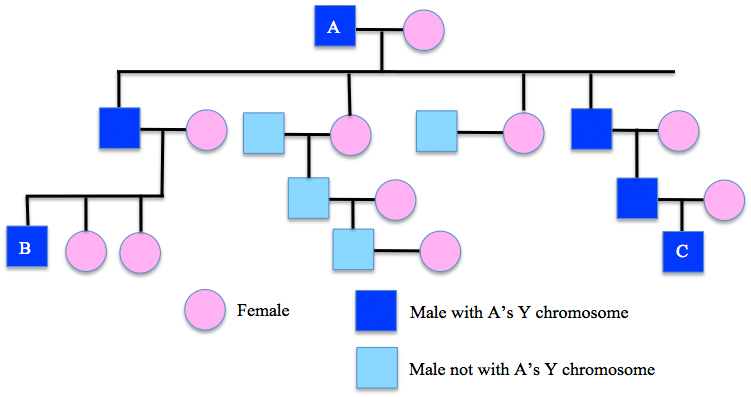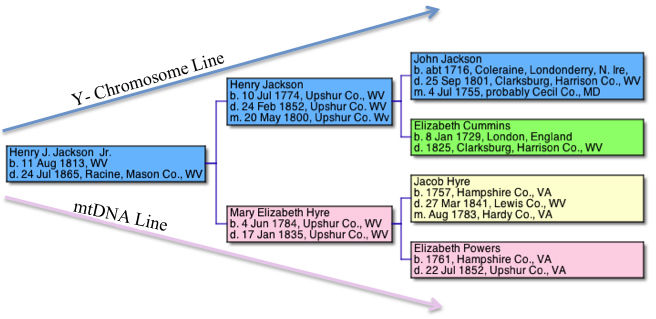
|
The Jackson Group of Family Tree DNA has a web site at http://www.familytreedna.com/public/Jackson/
Those who had high school biology will remember that humans have 23 pairs of chromosomes (for a total of 46 chromosomes). The chromosome pair designated 23 is special and determines the sex of the individual. When forming the chromosome pair 23, if the individual receives an X chromosome from the mother and an X chromosome from the father, the individual is female (XX). If the individual receives an X chromosome from the mother and a Y chromosome from the father, the individual is male (XY). The Y chromosome is passed from the father to the son virtually unchanged.
The Y in Y-DNA testing refers to the Y chromosome passed from a father to a son. The reason Y-DNA testing is especially useful for genealogy is that the Y chromosome is passed intact from father to son down through the generations in the same way surnames are passed in most cultures. Here is a Descendant Chart that shows how male A passes on his Y-chromosome.

|

|
For example, going back five generations, you have in your Pedigree Chart 64 ancestors (2 parents, 4 grandparents, 8 great grandparents, 16 great-great grandparents and 32 great-great-great grandparents) assuming no cross marriages such as with two first cousins marrying. Assuming you are male, Y-DNA testing only supplies information about the five direct male ancestors (your father, his father, his father, etc.) along the Y-Chromosome Line (the blue boxes in the above Pedigree Chart). A Y-DNA test says nothing about the other 59 ancestors!
However, even with this severe limitation, the Y-DNA test can be useful for genealogy. For example, a family history researcher could use it to determine if two branches of a surname share a common ancestor. The researcher just has to identify a male from each surname branch that descends through the male lineage back to the common ancestor. Most researchers would identify two males from each branch in case one individual might have a "hidden" adoption or an infidelity. Y-DNA tests deal with strictly male blood lines.
The "67" in the Y-DNA67 test refers to the number of markers used in the test. In genetic genealogy (the name for using genetics for genealogy), DNA labs use completely different markers from the ones used by the police at crime scenes as seen on CSI and the ones used by the medical profession for susceptibility to diseases. If one is considering a Y-DNA test, he need not worry about the police knocking on his door or about revealing health issues. Y-DNA tests specific markers on a male's Y-chromosome known as Short Tandom Repeat, or STR markers. The number of markers tested by most DNA testing companies can range from a minimum of 12 to as many as 111, with 67 being commonly considered a useful amount. Having additional markers tested will generally refine the predictive period in which two individuals are related, helpful for affirming or disproving a genealogical connection on the direct paternal line. Testing for more markers increases the cost. Testing for Y-DNA67 currently costs about $250 per individual; however, Family Tree DNA recently had a sale where they charged $200.
For more details on DNA testing visit Blair Genealogy's great web site: DNA 101
John and Lee's Y-DNA matched 66 markers out of the 67. This gives a 95% probability of a common ancestor in the last 8 generations. Since John descends from John and Elizabeth Jackson's son Henry and is 8 generations away and Lee descends from John and Elizabeth Jackson's son John Jr. and is 6 generations away, this makes sense. If you consider more generations, we have a 99% statistical probability of a connection sometime - anytime - within the last 12 generations.
From the two Y-DNA tests, we can determine the haplogroup for the John Jackson/Elizabeth Cummins line. It is a very common one (R1b1a2). A large percentage of Western Europe is in this haplogroup! One study determined 92.3% of the men in Wales and 85.4% of the men in Ireland are in this haplogroup. Another study states that in parts of north-western Ireland the R1b1a2 haplogroup reaches 98%. This seems to confirm that John Jackson was from Ireland.
We hope eventually the effort and money that went toward establishing our DNA baseline will work to others' advantage. We know a lot of folks want to believe they are related to Stonewall Jackson's line!! Now they have a way to verify that! But they will have to pay for the 67 marker test because the lower level tests just won't do the job for this common haplotype.
Please contact Dan Hyde (hyde at bucknell dot edu) if you are interested in comparing your Y-DNA tests with our baseline data.